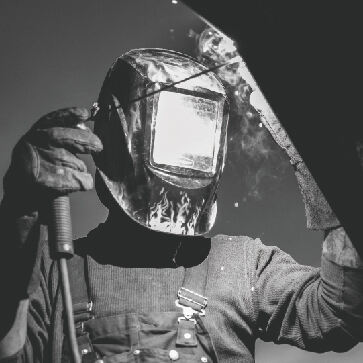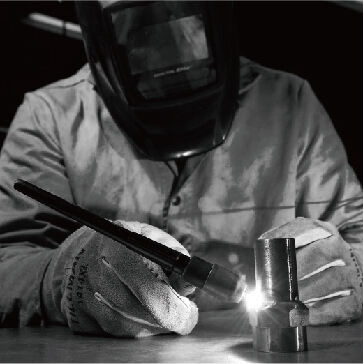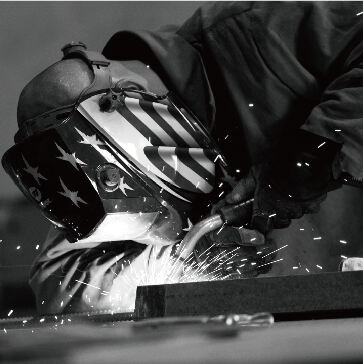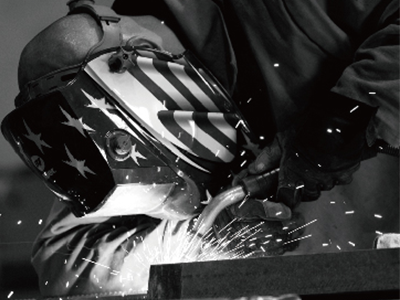용접은 원자 결합을 통해 영구적인 연결을 달성하기 위해 충전재 유무에 관계없이 열이나 압력 또는 두 가지 모두를 적용하여 공작물의 재료를 결합하는 프로세스입니다. 아크 기반 용접을 아크 용접이라고 합니다. 가장 일반적인 유형의 아크 용접에는 스틱 용접(MMA), MIG/MAG 용접(GMAW) 및 TIG 용접(GTAW)이 있습니다.
이번 글에서는 MIG 용접이 무엇인지, TIG 및 MMA 용접과 어떻게 다른지, MIG 용접의 장점과 단점에 대해 소개하겠습니다.
MIG 용접이란? 어떻게 작동합니까?
MIG/MAG 용접에서 아크는 용접 와이어와 모재를 녹여 용융 풀과 용접 영역을 형성하며, 이는 불활성 가스 또는 활성 가스로 보호되어 주변 공기의 유해한 영향을 효과적으로 방지할 수 있습니다.
MAG 용접(Metal Active Gas Welding)은 이산화탄소(CO2) 또는 CO2와 아르곤의 혼합물과 같은 활성 가스를 보호 가스로 사용합니다. 이러한 반응성 가스는 용접 풀과 상호 작용하여 용접의 화학적 조성과 기계적 특성에 영향을 미칠 수 있습니다. 연강, 스테인리스 스틸 등의 철금속에 일반적으로 사용됩니다.
MIG 용접(금속 불활성 가스 용접)은 불활성 가스(보통 아르곤 또는 헬륨)를 사용하여 용접 풀을 대기 오염 물질로부터 보호합니다. 이 공정은 특히 알루미늄, 구리 등 비철금속 용접에 효과적입니다.

MIG 용접과 TIG 용접의 차이점은 무엇입니까?
MIG 용접과 TIG 용접의 가장 분명한 차이점은 전극을 사용한다는 것입니다.
MIG 용접 공정은 연속적으로 공급되는 소모성 와이어 전극을 사용하여 두 개의 금속 조각을 결합합니다. TIG는 비소모성 텅스텐 전극과 별도의 용가재를 사용합니다. MIG 용접은 한 손으로만 할 수 있지만 TIG 용접에서는 한 손에는 TIG 용접건을, 다른 한 손에는 충진재를 잡아야 합니다. 필러 스틱을 잡는 것은 때때로 용접공에게 번거로울 수 있지만 호를 따라 필러 재료를 정확하게 적용할 수 있기 때문에 더 큰 제어력을 제공합니다.
MIG 용접은 일반적으로 배우기 쉽고, 작동하기 쉽고, 더 빠르고, 두꺼운 재료를 용접하는 데 더 나은 것으로 간주됩니다. 그러나 TIG 용접은 더 제어되고 더 정확하며 얇은 재료를 용접하는 데 적합하며 마무리 작업이 거의 또는 전혀 필요하지 않은 깔끔한 용접을 생성합니다.

MIG 용접과 MMA 용접의 차이점은 무엇입니까?
MIG는 연속 와이어 전극을 사용하고 보호 가스에 의존하는 반면, MMA 용접기는 전극 자체가 용접 웅덩이를 녹이고 덮는 보호 코팅을 제공하므로 보호 가스가 필요하지 않습니다.
MMA 용접은 높은 응력과 변형을 견딜 수 있는 강력하고 내구성 있는 용접을 생성하기 때문에 강철이나 주철과 같은 두꺼운 재료를 용접하는 데 자주 사용됩니다. 전극 코팅이 바람과 날씨로부터 어느 정도 보호해 주기 때문에 옥외나 바람이 많이 부는 환경에서도 용접에 사용할 수 있습니다.
MMA 용접은 꾸준한 손과 용접 아크의 좋은 제어가 필요하기 때문에 MIG 용접보다 마스터하기가 더 어렵습니다. 또한 작업자는 올바른 전극 각도를 유지하고 전극과 작업물 사이에 일정한 거리를 유지하도록 주의해야 합니다.

MIG 용접의 장점
1. 사용하기 쉬운
MIG 용접은 비교적 배우기 쉽고 조작이 쉬워 초보자도 쉽게 익힐 수 있으며 숙련된 용접사도 효율적으로 조작할 수 있습니다.
2. 높은 생산성
MIG 용접은 용접봉을 자주 교체하거나 용접 슬래그를 제거할 필요가 없기 때문에 시간을 절약하고 생산성을 향상시킬 수 있습니다.
3. 다양성
MIG 용접은 매우 다재다능하며 알루미늄, 구리, 스테인리스강, 연강 등과 같은 다양한 금속 및 합금을 용접할 수 있으며 DIY, 주택 용접, 자동차 수리 및 산업 응용 분야에 적합합니다.
4. 용접 부위 청소
SMAW(스틱 용접)와 같은 다른 공정과 비교할 때 MIG 용접은 일반적으로 스패터와 슬래그를 최소화하여 보다 깨끗한 용접을 생성하므로 용접 후 청소의 필요성이 줄어듭니다.
5. 우수한 용접 결과
MIG는 용접 풀에 대한 더 나은 가시성을 제공합니다. 프로세스의 단순성과 자동 와이어 공급을 통해 제공되는 향상된 제어 기능이 결합된 MIG는 쉽게 좋은 용접 결과를 생성할 수 있습니다.
6. 모든 위치 용접 기능
MIG 용접은 모든 위치(예: 평면 용접, 수직 용접, 수평 용접, 오버헤드 용접)에서 수행할 수 있으므로 다양한 응용 시나리오에서 매우 유연합니다.
MIG 용접의 단점
1. MIG는 대부분의 용접 공정보다 깨끗하지만 얇은 판금과 관련된 "미적 품질" 프로젝트에서는 MIG를 이길 수 없습니다.
2. 초기비용이 많이 든다. MIG 용접기를 사용하는 것은 스틱 용접기를 사용하는 것만큼 저렴하지 않습니다. 좋은 소식은 MIG 용접기가 수년 동안 지속된다는 것입니다.
3. 실외 사용에는 적합하지 않습니다. 바람이나 미풍이 불면 보호 가스가 날아가서 용접부가 오염 물질에 노출됩니다. 또한, 보호가스 공급이 필요하다는 것은 용접기를 자주 이동시키는 것도 쉬운 일이 아니라는 것을 의미합니다.
MIG 용접기 자주 묻는 질문
1.MIG 용접인가 좋은 초보자를 위해?
예, MIG 용접은 사용 편의성, 다양성 및 효율성으로 인해 초보자에게 권장되는 경우가 많습니다. 대부분의 MIG 용접기에는 조정 가능한 전압 및 와이어 공급 속도 설정이 제공되므로 초보자가 특정 요구 사항에 맞게 기계를 미세 조정하고 용접 기술을 향상시킬 수 있습니다.
2.MIG 용접기가 그만한 가치가 있나요?
예, MIG 용접기는 많은 사용자에게 가치가 있으며 강철, 스테인리스강, 알루미늄을 포함한 다양한 금속을 용접할 수 있으며 초보자와 숙련된 용접공에게 적합합니다. 프로세스가 더 빠르고 용접 후 청소가 적기 때문에 DIY, 주택 프로젝트, 자동차 수리 및 산업에 이상적입니다.
3.MIG 용접기로 알루미늄을 용접할 수 있나요?
예, MIG 용접기로 알루미늄을 용접할 수 있지만 몇 가지 구체적인 고려 사항이 필요합니다.
적절한 장비: 더 부드러운 알루미늄 와이어를 공급하려면 스풀 건이나 푸시-풀 시스템이 있는 용접기를 사용하십시오.
보호 가스: 아르곤 가스는 일반적으로 알루미늄 용접에 사용됩니다.
설정: 알루미늄은 강철보다 더 많은 열을 필요로 하므로 더 높은 열 입력에 대한 설정을 조정합니다.
4.MIG 용접기로 무엇을 용접할 수 있나요?
MIG 용접은 강철, 스테인리스강, 탄소강 등 다양한 금속이나 금속합금에 사용할 수 있습니다.,마그네슘,니켈,구리와 알루미늄.
5.가스 없이 MIG 용접을 할 수 있나요?
예, 플럭스 코어 아크 용접(FCAW)이라는 프로세스를 사용할 수 있습니다. 실외 및 바람이 많이 부는 조건에 편리하지만 가스 차폐 MIG 용접보다 슬래그와 스패터가 더 많이 발생하는 경향이 있습니다.

 EN
EN
 AR
AR
 BG
BG
 HR
HR
 CS
CS
 DA
DA
 NL
NL
 FI
FI
 FR
FR
 DE
DE
 EL
EL
 HI
HI
 IT
IT
 JA
JA
 KO
KO
 아니
아니
 PL
PL
 PT
PT
 RO
RO
 RU
RU
 ES
ES
 SV
SV
 TL
TL
 IW
IW
 ID
ID
 LV
LV
 LT
LT
 SR
SR
 SK
SK
 SL
SL
 UK
UK
 VI
VI
 HU
HU
 TH
TH
 TR
TR
 MS
MS
 BE
BE
 KK
KK
 KY
KY

